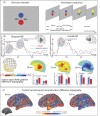Near-instant automatic access to visually presented words in the human neocortex: neuromagnetic evidence
- PMID: 27217080
- PMCID: PMC4877599
- DOI: 10.1038/srep26558
Near-instant automatic access to visually presented words in the human neocortex: neuromagnetic evidence
Abstract
Rapid and efficient processing of external information by the brain is vital to survival in a highly dynamic environment. The key channel humans use to exchange information is language, but the neural underpinnings of its processing are still not fully understood. We investigated the spatio-temporal dynamics of neural access to word representations in the brain by scrutinising the brain's activity elicited in response to psycholinguistically, visually and phonologically matched groups of familiar words and meaningless pseudowords. Stimuli were briefly presented on the visual-field periphery to experimental participants whose attention was occupied with a non-linguistic visual feature-detection task. The neural activation elicited by these unattended orthographic stimuli was recorded using multi-channel whole-head magnetoencephalography, and the timecourse of lexically-specific neuromagnetic responses was assessed in sensor space as well as at the level of cortical sources, estimated using individual MR-based distributed source reconstruction. Our results demonstrate a neocortical signature of automatic near-instant access to word representations in the brain: activity in the perisylvian language network characterised by specific activation enhancement for familiar words, starting as early as ~70 ms after the onset of unattended word stimuli and underpinned by temporal and inferior-frontal cortices.
Figures

Similar articles
-
Acquisition and consolidation of novel morphology in human neocortex: A neuromagnetic study.Cortex. 2016 Oct;83:1-16. doi: 10.1016/j.cortex.2016.06.020. Epub 2016 Jul 9. Cortex. 2016. PMID: 27458780
-
Formation of neocortical memory circuits for unattended written word forms: neuromagnetic evidence.Sci Rep. 2018 Oct 25;8(1):15829. doi: 10.1038/s41598-018-34029-y. Sci Rep. 2018. PMID: 30361630 Free PMC article.
-
MVPA Analysis of Intertrial Phase Coherence of Neuromagnetic Responses to Words Reliably Classifies Multiple Levels of Language Processing in the Brain.eNeuro. 2019 Aug 14;6(4):ENEURO.0444-18.2019. doi: 10.1523/ENEURO.0444-18.2019. Print 2019 Jul/Aug. eNeuro. 2019. PMID: 31383728 Free PMC article.
-
Words in the brain's language.Behav Brain Sci. 1999 Apr;22(2):253-79; discussion 280-336. Behav Brain Sci. 1999. PMID: 11301524 Review.
-
Language outside the focus of attention: the mismatch negativity as a tool for studying higher cognitive processes.Prog Neurobiol. 2006 May;79(1):49-71. doi: 10.1016/j.pneurobio.2006.04.004. Epub 2006 Jun 30. Prog Neurobiol. 2006. PMID: 16814448 Review.
Cited by
-
Impaired neural mechanism for online novel word acquisition in dyslexic children.Sci Rep. 2018 Aug 24;8(1):12779. doi: 10.1038/s41598-018-31211-0. Sci Rep. 2018. PMID: 30143722 Free PMC article.
-
Relevance acquisition through motivational incentives: Modeling the time-course of associative learning and the role of visual features.Imaging Neurosci (Camb). 2024 May 8;2:imag-2-00162. doi: 10.1162/imag_a_00162. eCollection 2024. Imaging Neurosci (Camb). 2024. PMID: 40800342 Free PMC article.
-
Parafoveal previews and lexical frequency in natural reading: Evidence from eye movements and fixation-related potentials.J Exp Psychol Gen. 2019 Mar;148(3):453-474. doi: 10.1037/xge0000494. Epub 2018 Oct 18. J Exp Psychol Gen. 2019. PMID: 30335444 Free PMC article.
-
Contextual Acquisition of Concrete and Abstract Words: Behavioural and Electrophysiological Evidence.Brain Sci. 2021 Jul 7;11(7):898. doi: 10.3390/brainsci11070898. Brain Sci. 2021. PMID: 34356132 Free PMC article.
-
Early lexical processing of Chinese one-character words and Mongolian words: A comparative study using event-related potentials.Front Psychol. 2023 Jan 17;13:1061990. doi: 10.3389/fpsyg.2022.1061990. eCollection 2022. Front Psychol. 2023. PMID: 36733864 Free PMC article.
References
-
- Eldredge D. H. & Miller J. D. Physiology of hearing. Annu Rev Physiol 33, 281–310 (1971). - PubMed
-
- Rupp A. et al.. The representation of peripheral neural activity in the middle-latency evoked field of primary auditory cortex in humans(1). Hear Res 174, 19–31 (2002). - PubMed
-
- Pulvermüller F., Shtyrov Y. & Ilmoniemi R. Spatiotemporal dynamics of neural language processing: an MEG study using minimum-norm current estimates. Neuroimage 20, 1020–1025 (2003). - PubMed
-
- Shtyrov Y. & Pulvermüller F. Early MEG activation dynamics in the left temporal and inferior frontal cortex reflect semantic context integration. J Cogn Neurosci 19, 1633–1642 (2007). - PubMed
-
- Zhong Y. M. & Rockland K. S. Inferior parietal lobule projections to anterior inferotemporal cortex (area TE) in macaque monkey. Cereb Cortex 13, 527–540 (2003). - PubMed
Publication types
MeSH terms
Grants and funding
LinkOut - more resources
Full Text Sources
Other Literature Sources

